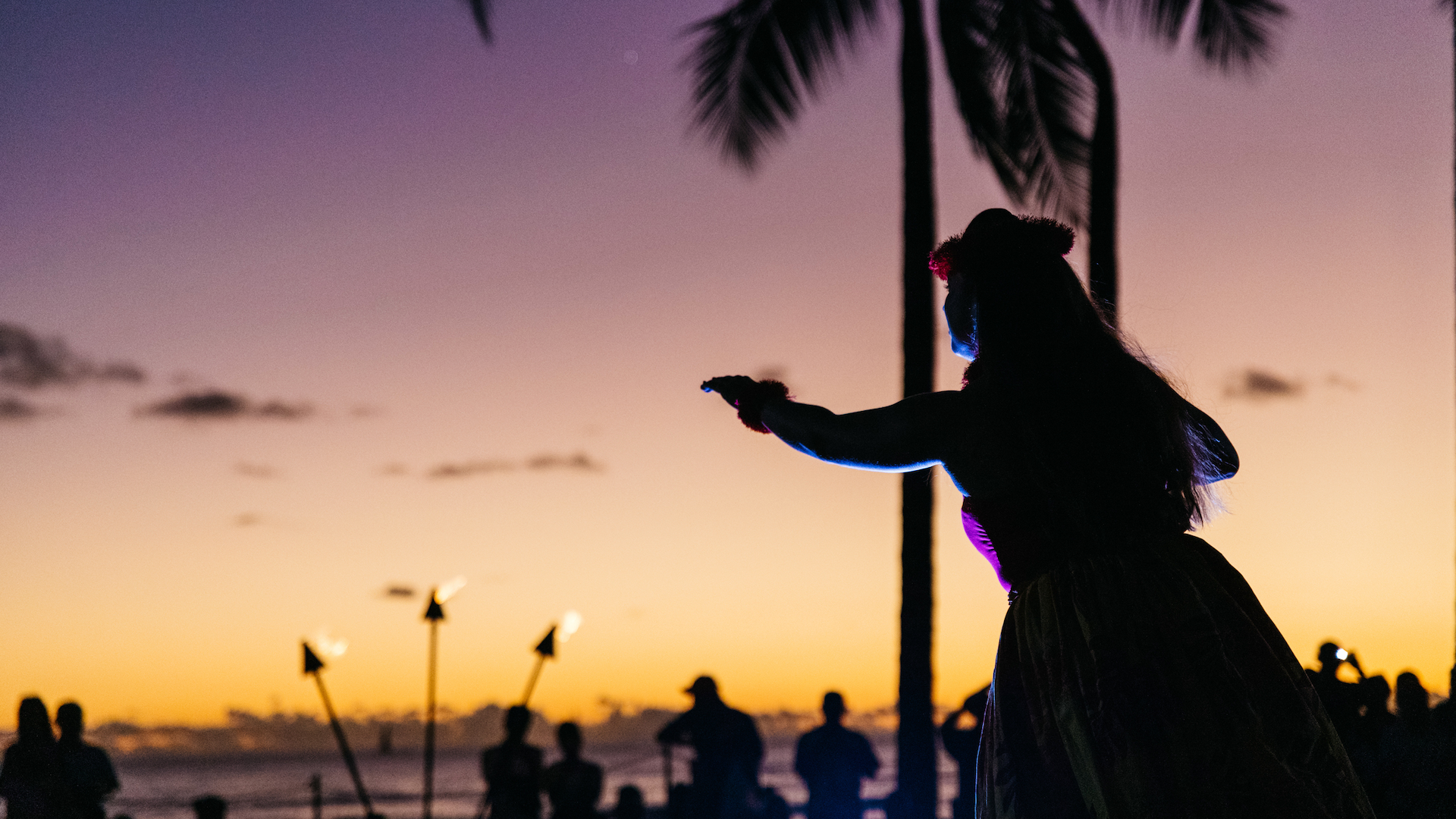Hawaii Tourism has sponsored this article and is our source of the photos used in it.
Hawaii “Local”
The Native Hawaiians migrated to the Hawaiian Islands, where they thrived for centuries, carrying their cultural traditions and developing new ones. Over time, the islands saw the arrival of a diverse group of people, including Christian missionaries who converted many Hawaiians and immigrant labourers who worked in the sugar cane plantations. As with any cultural exchange, assimilation, adaptation, and innovation occurred, creating a shared culture of diverse influences commonly referred to as “local.” Despite this, many Native Hawaiian customs have been preserved and are still practiced today.
Video: Navigating the Stars: Hawaii Rooted
Under the stars on the island of Maui, Kala Tanaka connects with her ancestors through traditional Hawaiian voyaging. Discover more of Kala’s #HawaiiRooted story at Hawaii Tourism.
The Native Traditions of Hawaii
1. The honi ihu, or touching of noses, is a traditional method of greeting one another. Whether it’s a man and woman, two men or two women, both exchange breath, which is the vital life force in Hawaiian understanding. Also, sharing scents conveys a closeness in the relationship.
2. Made out of flowers, bird feathers, shells, seeds, hair or ivory, the lei (garland or wreath) has become a symbol of Hawaii. Worn on the top of the head or around the neck, lei were used ornamentally by Native Hawaiians, especially chiefs, to signify their rank. Giving a lei was a traditional practice, but not like the ceremonious welcome practice that has become the local custom today. The presentation was also different: it was tied around the neck, rather than casting the lei over the head, respecting the sacredness of a person’s head and back.
Halau performing hula kahiko. Photo credit to Hawaii Tourism Authority.
“Hula is a complex art form performed for religious purposes.”
3. Hula is a complex art form performed for religious purposes, entertainment and to preserve historical events, genealogy and mythology through movements accompanied by chants. It is a serious and sacred pursuit that requires rigorous training, technical skill, and academic knowledge taught by respected kumu (teachers) who advance wisdom from a long lineage of masters. Unlike a lot of hulas performed today, hula wasn’t meant to be a spectacle and was often performed privately.
Visitors to Hawaii earn a free hotel night or a special discount. We book Malama Hawaii vacation packages, contact us if you have any questions.
“Mālama Hawaii, giving back.”
4. A coveted value, malama aina (take care of the land) upholds the strong connection Hawaiians have to the land. It provided food, nourishment and sustainability, so it was a profound privilege and duty, or kuleana, to take care of it in return by being great stewards, so that everyone, including future generations, could thrive from the bounty of the islands’ natural resources. This ethos still drives many of Hawaii’s taro farmers, fishpond caretakers and ecologists and conservationists of all stripes.
5. Hawaiian parties are called paina (dinner party) or ahaaina (feast), but a misunderstanding by 19th-century newspaper reporters gave these distinctive celebrations the name luau (the name for taro tops, a common ingredient in Hawaiian cuisine), and it stuck. Though not an ancient name usage, the sentiments are similar – they brought together groups of people to enjoy delicious food.
At a time in Hawaii’s history, the sugar industry grew, and plantations multiplied. Therefore, immigrant labourers were brought largely from China, Portugal, Japan, Korea, Puerto Rico and the Philippines. This diverse group of people living together in close-knit communities created a melting pot of cultures. Therefore, this produced a unique blend of customs that have roots in many areas of the globe, collectively called “local.”
Related reading, Kauai Vacation: Top 5 Sites On The Island That Are Not to Be Missed.
Contemporary Local Customs
1. Derived from the traditional Hawaiian honi ihu, a hug and a kiss on the cheek is a common greeting in Hawaii, whether you’re meeting friends, family or new people. At business meetings, handshakes are still acceptable.
2. Understanding the semantics of the language shows respect to the island and the people you’re visiting. Only refer to things as “Hawaiian” if you’re talking about the indigenous culture and people of Hawaii. Non-Hawaiians are referred to as “locals” or “kamaaina” (“child of the land”).
“Hawaiian Pidgin English is a Creole language.”
3. Hawaiian Pidgin English is a Creole language. It was created at a time when various immigrants and Hawaiians needed a way to communicate with each other. A mixture of words from different languages sounds like broken English to uninformed listeners. Don’t attempt Hawaiian Pidgin English unless you’re fluent, as it may be perceived as mockery or disrespect.
4. Wearing a flower tucked above your left ear (the same side as your heart) discreetly communicates that you have a significant other. While a flower tucked above your right ear lets others know you’re available. This practice has no roots in Hawaiian culture but is a fun local custom.
5. It is not common to use a car horn while driving in Hawaii (unless you are honking a friendly hello). Instead, waving or throwing a shaka when someone lets you into their lane is encouraged.
Local honey for sale at Maui street festival.
“It is considered a kind gesture to bring omiyage.”
6. It is considered a kind gesture to bring omiyage (gifts) from far away for family or friends. Unlike a standard souvenir, such as a magnet or postcard, the idea is to choose items that can’t be found in the recipient’s region, especially food. For instance, buying a box of macadamia nuts for a friend back home where they are not common, or bringing a box of special cookies to a friend on another Hawaiian Island where they are unavailable. Gifts of food are also given in exchange for favours.
7. Speaking of gifts, don’t take rocks or sand from the beach or lava rocks from a volcano. Superstition says that people who take them will be cursed! which. Most likely, this probably gets its roots from the high esteem Hawaiian culture has always held for rocks. In a lithic culture, stones were used for many things, such as tools, fences, and housing – they can even be forms of deities. Leaving rocks as you found them is the best practice.
“Take off your shoes before entering someone’s house.”
8. Take off your shoes before entering someone’s house. You’ll rarely find a house in Hawaii that doesn’t follow this practice. Observing the customs respects your hosts and keeps the dirt outside.
9. Give a lei gift to welcome someone or say, “a hui hou” (until we meet again). Lei are also appropriate gifts at graduations, birthdays or other special occasions. It’s a bad omen to give a pregnant woman a closed lei (a representation of an umbilical cord wrapping around the neck of a child). So, ask the florist to make it open-ended.
10. A person’s humility is generally more valuable than a person’s connections or financial worth. So, wearing flashy clothes or name-dropping in Hawaii is perceived as arrogance rather than pride.
“Hawaii is not a state of mind but a state of grace.” – Paul Theroux.
Thank you for reading.
Contact us today to book your dream trip to Hawaiian Islands.


